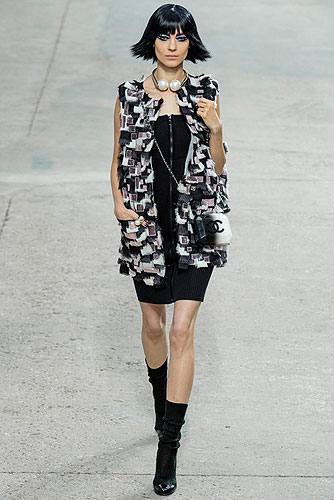
























































































Karl Lagerfeld had a great summer: The sun shone, Choupette was happy, creative juices geysered.
www.chanel.comParisFashion WeekFashion Brand
Karl Lagerfeld had a great summer: The sun shone, Choupette was happy, creative juices geysered.
Karl Lagerfeld had a great summer: The sun shone, Choupette was happy, creative juices geysered. The concept and the clothes for his new collection came together at the same time. Art! You can scarcely pick up a magazine or newspaper these days without coming across something about the volatility of the art world, the millions that are being spent in the getting of pictures on which the paint is scarcely dry. It's become a huge oligarchical pissing contest, with the annual art fair in Basel, Switzerland, its most competitive arena. And Lagerfeld, antennae attuned to every wrinkle of the here and now, didn't miss a trick with his Chanel/Basel mash-up today. Right there on the soundtrack: Jay-Z's "Picasso Baby," with its accompanying video ripe with images of art-world grandees lining up at the Pace Gallery in Chelsea so they could bask in Hova's glory.
The Grand Palais was transformed into a gigantic white-walled hangar of paintings and sculptures—quintessential Basel or Frieze—all seventy-five of them made by Lagerfeld during his Summer of Prodigious Creativity. He didn't actually make them himself—that feat would be too Olympian even for Karl—but he drew the pieces or made maquettes so his studio could realize the finished product. Just like Jeff Koons. And, as with Koons, Karl's reference points were identifiable, though he cleverly twisted them so they each included some element of Chanel: a camellia, a pearl, a bottle of No. 5. Some of them had red dots beside their titles, like they'd already been sold. Postshow, he wearily insisted he had no intention of doing any such thing; he'd already been asked a thousand times, just like he'd been asked to sign the whole lot.
The coming together of concept and design was clearly responsible for the way Lagerfeld's theme infected his collection to a greater degree than usual. "Transformative!" was Koons' response at Stella McCartney's show the other day when he was asked about the common ground between art and fashion, and the transformations the Chanel atelier achieved with the signature tweeds were nothing short of art. In fact, they weren't even tweed as we know it: They were some indefinable multi-processed hybrid of de- and reconstructed stuff that was then mounted on tulle to create outfits that were identifiable as iconic Chanel. Phew! And you can only imagine Lagerfeld's delight at fooling all of the people all of the time.
Deconstruction, trompe l'oeil, collage, bricolage—this Chanel collection was a fest of art processes. You never get the sense that Lagerfeld is pushing himself; he makes everything look much too easy for that. Nevertheless, in the ninety-ish looks he showed today, there were more stories than he would usually be bothered to tell. For instance, a paint chart from the 1900s yielded a whole group of primally Pantone-ed pieces. They were something quite new for Chanel. There were great things that looked like they'd been scissored from charcoaled canvas—again, in keeping with the theme but intriguingly raw for Chanel. And Lagerfeld's collaborators kept the dream alive with their impeccable contributions. Sam McKnight's wigs were paintbrushes-cum-Darth Vader helmets of hair. Peter Philips' makeup looked like an artist had wiped his brushes on eyelids instead of on clothes or canvas. Macabre maybe, but one more Chanel pointer to the transformative art of fashion at its most far-reaching.